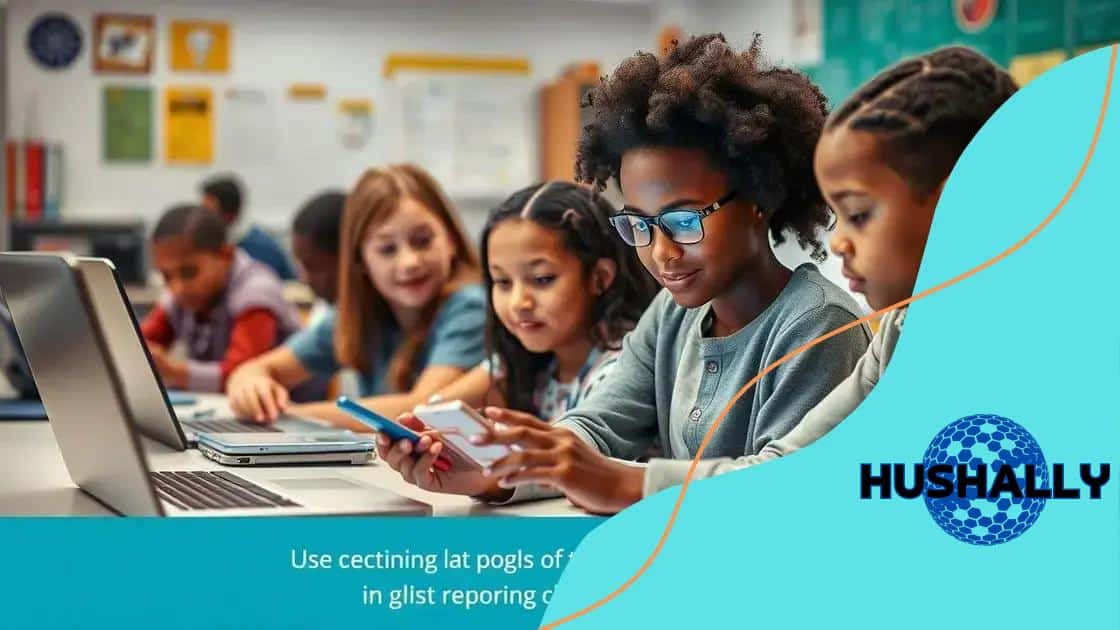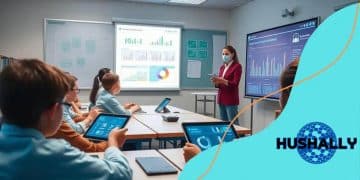AI support for special education: enhancing learning opportunities

AI support for special education enhances personalized learning, increases accessibility, and provides data-driven insights, ensuring that diverse learners receive tailored educational experiences that meet their unique needs.
AI support for special education plays a vital role in enhancing the learning journey for students with unique needs. Have you ever wondered how these tools can make a difference? Let’s dive into the ways AI is changing education for the better.
Understanding AI in special education
Understanding how AI works in special education can unlock new learning possibilities for students. Educators and parents are increasingly looking for innovative ways to support diverse learners.
What is AI?
Artificial Intelligence refers to computer systems that can perform tasks usually requiring human intelligence. This includes recognizing speech, making decisions, and understanding natural language.
How AI Supports Special Education
When integrating AI in special education, schools can provide tailored experiences that meet students’ unique needs. For example, AI can analyze how a student learns best and adjust the teaching methods accordingly.
- Personalized learning experiences
- Real-time feedback and assessments
- Improved engagement through interactive tools
Additionally, AI tools can assist educators in identifying specific areas where a student may need help. This targeted approach allows for more effective teaching methods.
Furthermore, AI can help manage classroom dynamics. For instance, AI-powered tools can predict when a student may feel overwhelmed and suggest breaks or alternative activities.
Real-World Applications
Schools are already seeing the benefits of AI applications in different ways. Some tools help in organizing data on student performance, which makes it easier for teachers to adjust their strategies.
- Speech recognition software for communication
- Adaptive learning platforms tailored to individual paces
- Behavior analysis software to monitor student interactions
In conclusion, using AI in special education makes it possible for educators to create a more inclusive and effective learning environment. This technology opens doors for students, allowing them to thrive academically and socially. Understanding these systems is crucial for anyone involved in education today.
Benefits of AI support for diverse learners
The benefits of AI support for diverse learners are significant and varied. By tailoring education to meet individual needs, AI can help all students reach their potential. Every learner deserves a chance to succeed, and AI can make that happen.
Personalized Learning Experiences
One of the main advantages of using AI in education is its ability to provide personalized learning experiences. This means that each student can learn at their own pace, making it easier for them to understand complex concepts.
- Customized lesson plans
- Adaptive materials for different learning styles
- Targeted support for specific challenges
Alongside personalized learning, AI uses data to identify gaps in students’ understanding. Instead of a one-size-fits-all approach, teachers can focus on areas where students struggle the most.
Enhancing Engagement
Another important benefit is increased student engagement. AI tools often incorporate interactive elements that capture students’ attention. Gamified learning experiences can make education fun and exciting.
- Interactive simulations and games
- Visual aids to enhance understanding
- Real-time feedback to motivate learners
These engaging methods allow students to feel more connected to the material. With AI support, lessons can be designed to keep students actively participating in their education.
Moreover, AI allows for quick adjustments based on student performance. If a student is excelling, the AI can present more challenging tasks. Conversely, if a student is struggling, the AI can provide additional resources and support.
Supporting Teachers
Finally, AI not only benefits students but also supports educators. Teachers can use AI to gather insights about their students’ progress and adapt their teaching methods accordingly. As educators receive real-time data, they can make informed decisions that enhance the learning experience for everyone.
- Efficient data collection on student performance
- Identifying trends and patterns in learning
- Providing resources tailored for individual needs
By leveraging these tools, teachers can focus more on teaching rather than spending time on administrative tasks, leading to improved educational outcomes.
Innovative AI tools for personalized learning

Innovative AI tools are revolutionizing personalized learning in classrooms. These tools adapt to the needs of each student, creating a more effective learning environment. As educators seek new methods, AI offers exciting possibilities.
Types of AI Tools
There are several types of AI tools designed to enhance personalized learning experiences. Each serves different goals, all aiming to benefit students.
- Adaptive learning platforms
- Intelligent tutoring systems
- AI-driven assessments
These platforms can adjust their content and approach based on how a student interacts with the material, ensuring they are challenged at the right level.
Adaptive Learning Platforms
Adaptive learning platforms use AI algorithms to customize educational content. They analyze a student’s performance in real-time and modify lessons accordingly. This makes learning more effective by recognizing when students need extra help or when they can move ahead.
Smart Tutoring Systems
Intelligent tutoring systems provide personalized feedback and guidance. They help students grasp difficult concepts by breaking down information into digestible parts. By simulating one-on-one tutoring interactions, these systems enhance understanding.
Real-Time Assessment and Feedback
AI-driven assessments allow for ongoing monitoring of student progress. Teachers receive insights and can adapt their teaching strategies based on data. This immediate feedback helps to identify strengths and weaknesses quickly.
- Creating a customized learning path
- Enhancing motivation by celebrating achievements
- Allowing for autonomous learning at each student’s pace
Additionally, these assessments can highlight patterns in learning, providing educators with valuable information on how to tailor instruction.
AI tools also promote a collaborative learning environment. Students can work together while using these systems, fostering teamwork and communication skills. This interaction is essential for developing social skills in a learning setting.
Examples of AI Tools
Several applications are leading the way in this innovative space. Programs like Khan Academy and DreamBox utilize AI to create personalized learning experiences for students.
- Khan Academy adapts exercises based on student performance
- DreamBox offers interactive math lessons tailored to student needs
- Century Tech provides data-driven insights into progress
As technology evolves, the potential for AI tools in personalized learning is immense. Integrating these tools into a classroom can support differentiated instruction effectively.
Strategies for implementing AI in classrooms
Implementing AI in classrooms can transform learning practices and enhance student outcomes. Schools can adopt various strategies to facilitate this integration smoothly.
Assessing Needs
First, it is crucial to assess the needs of both teachers and students. Understanding what challenges exist helps in selecting appropriate AI tools. Schools can hold surveys or focus groups to gather insights and identify specific areas where AI can provide support.
- Identify gaps in student learning
- Evaluate teacher comfort with technology
- Analyze existing resources and tools
Once needs are clear, schools can strategically choose tools that align well with their goals.
Providing Training
Training is another essential strategy for successful implementation. Educators must feel confident in using AI systems. Schools can organize workshops or professional development sessions focused on these technologies. This training should cover:
- How to effectively integrate AI into lesson plans
- Understanding the functionalities of the chosen tools
- Methods for tracking student progress using AI
With proper training, teachers can maximize the benefits of AI in their classrooms.
Creating a Supportive Environment
Creating a supportive environment for both students and teachers is vital. This means ensuring that there is technical support readily available. Schools should have dedicated staff to assist with any technical issues that may arise during class.
Furthermore, fostering a culture open to change will encourage experimentation with AI tools. Students should feel comfortable expressing how technology affects their learning. Feedback systems can help educators continually improve their approaches.
Implementing Gradually
Starting small is an advisable approach. Schools can begin by implementing a single AI tool in one subject or grade. This allows for focused evaluation and refinement of the integration process. Once teachers and students become familiar with the tool, it can be expanded to other areas.
Tracking the impact of AI on student learning is also essential. By assessing students’ performance and engagement, schools can determine if the AI implementation meets educational goals.
Engaging Parents and Community
Lastly, engaging parents and the community in the conversation about AI in education is important. Schools can host events to explain the benefits and answer any questions. This partnership fosters a shared understanding and support for the changes.
- Organize informational meetings
- Share success stories and data
- Invite community input and feedback
By creating a collaborative environment, schools can ensure a more seamless transition into an AI-enhanced educational landscape.
Future trends in AI and inclusive education
Future trends in AI and inclusive education promise to enhance learning experiences for all students. As technology evolves, its integration into the classroom continues to offer innovative solutions.
Increased Personalization
One of the main trends is the move towards increased personalization. AI tools will become more sophisticated in designing custom learning pathways for students. Each student’s unique needs can be addressed more effectively as AI systems learn from their interactions.
- Tailored curriculum based on individual learning styles
- Flexible assignment modifications to suit student abilities
- Continuous feedback loops for ongoing improvement
This level of personalization will help students engage more deeply with the content, resulting in better academic outcomes.
Enhanced Accessibility
Another trend is the focus on enhanced accessibility. AI is helping break down barriers faced by students with disabilities. Technologies like speech recognition and text-to-speech systems are developing rapidly.
These tools are crucial for creating inclusive environments, allowing students who might otherwise struggle to participate fully. By providing multiple ways to engage with material, AI can make education more equitable for everyone.
Data-Driven Insights
Data will play a significant role in shaping future educational strategies. AI can analyze vast amounts of information to produce actionable insights. Educators will benefit from understanding trends in student performance at a deeper level.
- Identifying at-risk students early
- Understanding common learning barriers faced by groups
- Improving resource allocation for maximum impact
These insights can drive targeted interventions, ensuring that no student falls behind.
Collaborative Learning Environments
Additionally, future trends may emphasize collaborative learning environments enhanced by AI. Classroom technology will not only facilitate individual learning but also foster collaboration among students.
Tools that support teamwork will enable peers to work together seamlessly, sharing ideas and solving problems. This collaboration and interaction are vital skills for the workforce of the future.
Integration of Virtual and Augmented Reality
Finally, the integration of virtual and augmented reality into education is on the rise. These technologies can create immersive learning experiences that are both engaging and informative.
- Simulations that allow students to explore new concepts
- Virtual field trips that broaden perspectives
- Interactive lessons that foster deeper understanding of complex topics
By incorporating these elements, educators will capture the attention of diverse learners while making education more accessible and enjoyable for all.
FAQ – Frequently Asked Questions about AI in Education
How can AI personalize learning for students?
AI analyzes individual student data to create customized learning paths, ensuring each student receives the right support based on their unique needs.
What are the benefits of using AI for students with disabilities?
AI provides tools that enhance accessibility, helping students with disabilities engage fully in the learning process through personalized assistance.
How can teachers use data from AI tools effectively?
Teachers can leverage data insights to identify student strengths and weaknesses, enabling them to tailor their teaching strategies for better educational outcomes.
What innovative technologies are being integrated into classrooms?
Technologies like virtual reality (VR) and augmented reality (AR) are being used to create immersive learning experiences that enhance student engagement and understanding.





